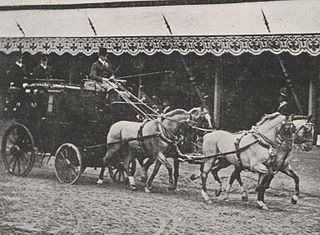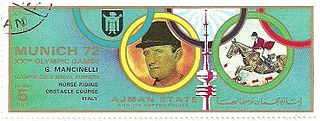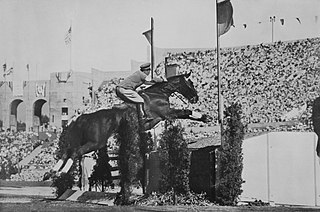Five equestrian competitions were held from 29 May to 2 June 1900 at the Concours Hippique International in Paris as part of the Exposition Universelle. The events were later classified as part of the 1900 Summer Olympics. The events were organised by the Société hippique française, with competitors from eight countries competing in three jumping and two driving events at the Place de Breteuil in the 7th arrondissement of Paris.

At the 1900 Summer Olympics one gymnastics event for men was contested. The competition was held on Sunday, 29 July 1900, and on Monday, 30 July 1900. There were 135 competitors from 8 nations. The top 18 places were taken by French gymnasts, of which there were more than 100. The event was won by Gustave Sandras, with Noël Bas finishing second and Lucien Démanet third. The highest-placing foreign gymnast was Jules Ducret of Switzerland, in a tie for 19th place.

The Russian Empire competed at the 1900 Summer Olympics in Paris. It was the first appearance of the European nation, which had entered the names of competitors for the first modern Olympics in 1896 but had failed to appear.

Equestrian sports were first included in the Olympic Games in the Summer Olympics of 1900 in Paris. They were again included in 1912, and have been included in every subsequent edition of the Games. Currently, the Olympic equestrian disciplines are dressage, eventing, and show jumping. In each discipline, both individual and team medals are awarded. Since the XV Olympiad in Helsinki in 1952, women and men compete on equal terms.
Equestrian competitions in all three disciplines at the Beijing 2008 Summer Olympics were held from 9 August to 21 August at the Hong Kong Sports Institute and Sheung Yue River in Hong Kong. It was the second time that the equestrian events were hosted by a member of the IOC other than the member hosting the main games. Unlike 1956, however, the equestrian events were part of the main games, and were held within the same period.

The individual show jumping was an equestrian event held as part of the Equestrian at the 1912 Summer Olympics programme. The competition was held on 16 July 1912 as the Stockholm Olympic Stadium. There were 31 competitors from 8 nations. Each nation was limited to a maximum of six riders. The event was won by Jacques Cariou of France, the nation's first victory in the individual jumping. The victory came with a challenge prize presented by Count Gyula Andrássy the Younger of Hungary. Rabod von Kröcher earned Germany's first medal in the event with his silver. Emmanuel de Blommaert of Belgium took bronze.

Obstacle jumping was one of five equestrian competitions held in late May and early June 1900 at the International Horse Show in Paris. The event was part of the Exposition Universelle, and later classified as part of the 1900 Summer Olympics. It was similar to the modern show jumping event. 45 competitors entered, though only 37 competed, with some information unknown. The event was won by Aimé Haegeman of Belgium, with his countryman Georges Van Der Poele taking second and Louis de Champsavin of France in third.

The long jump was one of five equestrian competitions held in late May and early June 1900 at the International Horse Show in Paris. The event was part of the Exposition Universelle, and later classified as part of the 1900 Summer Olympics. It is the only Olympic Games to feature an equestrian long jump competition. Of the seventeen competitors who entered, around half are known by name. The event was won by Constant van Langhendonck of Belgium, with Gian Giorgio Trissino of Italy in second and Jacques de Prunelé of France in third.

The "hacks and hunter combined", also known as the "chevaux de selle", was one of five equestrian competitions held in late May and early June 1900 at the International Horse Show in Paris. The event was part of the Exposition Universelle, and later classified as part of the 1900 Summer Olympics. It is unknown how many riders competed. The top four placers are known, as are about half the remaining riders who competed, including three women. As an upper limit, 50 men and 1 woman are listed as entrants in the Official Report, but it is almost certain that not all actually competed.

The four-in-hand mail coach driving was one of five equestrian competitions held in late May and early June 1900 at the International Horse Show in Paris. The event was part of the Exposition Universelle, and later classified as part of the 1900 Summer Olympics. There were 31 entrants listed for the event; all 28 of them are known by name. The event was won by the team of Georges Nagelmackers of Belgium. The teams of Léon Thome and Jean de Neuflize, both of France, were classified in second and third place respectively.

The individual show jumping event was part of the equestrian programme at the 1920 Summer Olympics. The competition was held on 12 September at the Olympisch Stadion in Antwerp. There were 25 competitors from 6 nations. The event was won by Tommaso Lequio di Assaba of Italy, with his teammate Alessandro Valerio earning silver. Carl Gustaf Lewenhaupt of Sweden took bronze. They were the first medals in individual jumping for both nations.

Dominique Maximilien Gardères was a French horse rider who competed in the 1900 Olympic Games. In Paris he tied to the gold medal in the high jump event with Gian Giorgio Trissino.

Count Giovanni Giorgio Trissino was an Italian horse rider who won Italy's first ever gold medal at the Olympic Games in Paris 1900.

The individual show jumping at the 2008 Summer Olympics took place between 15 and 21 August, at the Hong Kong Sports Institute. Like all other equestrian events, the jumping competition was mixed gender, with both male and female athletes competing in the same division. There were 77 competitors from 29 nations. The event was won by Eric Lamaze of Canada, the nation's first victory in individual jumping and first medal of any color in the event since 1976. Silver went to Rolf-Göran Bengtsson of Sweden, that nation's first medal in individual jumping since 1932. American Beezie Madden, who had led through the three qualifying rounds in 2004 before a bad first final round put her in 30th overall in Athens, took the bronze medal in Beijing.

The individual show jumping was one of five equestrianism events on the Equestrian at the 1924 Summer Olympics programme. The competition was held on Saturday 27 July 1924. 43 riders from 11 nations competed. Nations were limited to four riders each; the team jumping event used the same results as this competition, with the top three individual scores counting for each national team. The individual event was won by Alphonse Gemuseus of Switzerland, with the nation winning its first victory in its debut in the individual jumping event. Tommaso Lequio di Assaba of Italy became the first person to win multiple medals in the event, taking silver to add to his 1920 gold. Adam Królikiewicz earned Poland's first individual jumping medal with his bronze.

The individual show jumping in equestrian at the 1972 Summer Olympics in Munich was held at Olympic Stadium on 3 September. It was open to men and women. There were 54 competitors from 21 nations, with two additional non-starters. The event was won by Graziano Mancinelli of Italy, the nation's first victory in individual jumping since 1960 and third overall, tying France for most of all nations. Great Britain extended its podium streak in the event to four Games with Ann Moore's silver. The United States reach the podium for a second straight Games as Neal Shapiro took bronze.

The individual show jumping in equestrian at the 1932 Summer Olympics in Los Angeles was held on 14 August. The event was called the "Prix des Nations" at the time. There were 14 competitors from 4 nations.

The individual show jumping at the 1960 Summer Olympics took place on 7 September, at the Stadio Olimpico. The event was open to men and women. It was the 11th appearance of the event. There were 60 competitors from 23 nations. Each nation could have up to three riders. The event was won by Raimondo D'Inzeo of Italy, with his elder brother Piero D'Inzeo taking silver. The brothers were the second and third riders to win multiple medals in individual jumping; all three were Italian. It was the nation's first gold medal in the event since Lequio di Assaba's in 1920; Italy's two golds tied France for most all-time. David Broome earned Great Britain's first medal in the event with his bronze.

The individual show jumping at the 1968 Summer Olympics took place on 23 October. The event was open to men and women. There were 42 competitors from 15 nations. Each nation was limited to three riders. The event was won by William Steinkraus of the United States, the nation's first medal in individual jumping. Marion Coakes of Great Britain was the first female rider to win a medal in individual jumping, taking silver. Great Britain also earned its third consecutive bronze medal in the event, with David Broome earning his second to become the fifth person to win multiple medals in the event.


















